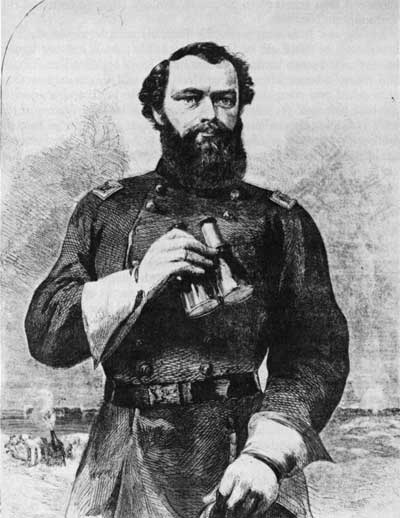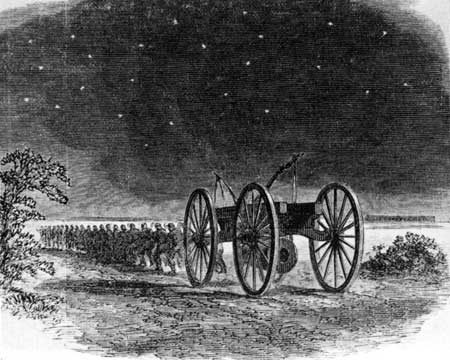|
FORT PULASKI National Monument |
 |

Brig. Gen. Q. A. Gillmore, who captured Fort Pulaski.
Harper's Weekly, September 12, 1863. Courtesy Gen.
Quincy A. Gillmore.
The New Weapon
The time had come to decide whether to take Fort Pulaski by force or to wait for the garrison to starve. The fort had been provisioned on January 28 with a 6 months' supply of food, which might have been made to last, by careful rationing, to mid-August or even September. Eventually, however, surrender would have been inevitable. Sherman was undoubtedly aware of these circumstances, but he does not seem to have given serious thought to playing a waiting game. The Northern press was clamoring for action, and Sherman, himself, was still bent on the quick capture of Savannah. Whatever merit this dream may have had will never be known, for on February 14 the Commanding General of the United States Army ordered the entire effort of the expeditionary force to be expended on the reduction of Fort Pulaski.
Long before this order reached headquarters on Hilton Head Island, Sherman had taken decisive action. On February 19 he sent his Chief Engineer, Capt. Quincy A. Gillmore, to take command of all troops on Tybee Island and to prepare for the bombardment of Fort Pulaski.
Gillmore was destined to play the leading role in the Fort Pulask story and win for the fort a permanent niche in the military annals of the United States. A brilliant member of the Corps of Engineers, he is described by the newspaper correspondent, Whitelaw Reid, as "a quick-speaking, quick-moving, soldierly man . . . a fine, wholesome looking, solid six footer, with big head, broad, good humored face, and a high forehead faintly elongated by a suspicion of baldness, curly brown hair and beard, and a frank open face." His greatest attribute as a soldier was a fearless disregard for tradition. At the Battle of Fort Pulaski, Gillmore was breveted a brigadier and later he became a major general of volunteers.

Guns were hauled by manpower.
From Harper's Pictorial
History of the War of 1861.
In 1862, Fort Pulaski was considered invincible. Its 7-1/2-foot solid brick walls were backed with massive piers of masonry. The broad waters of the Savannah River and wide swampy marshes surrounded the fort on all sides. Ships of the Navy could not safely come within effective range of this citadel, and there was no firm ground on which land batteries could be erected nearer than Tybee Island, from 1 to 2-1/2 miles away. All previous military experience had taught that beyond a distance of 700 yards smoothbore guns and mortars would have little chance to break through heavy masonry walls, and beyond 1,000 yards no chance at all.
In referring to Fort Pulaski, the United States Chief of Engineers, General Totten, said "you might as well bombard the Rocky Mountains." General Lee, himself, standing on the parapet of the fort with Colonel Olmstead, pointed to the shore of Tybee Island and remarked, "Colonel, they will make it pretty warm for you here with shells, but they cannot breach your walls at that distance." In the minds of the experts a long-range bombardment would merely serve to pave the way for a direct assault.
Gillmore held a different opinion. He was familiar with the test records of a new weapon, the rifled gun, with which the Army had begun to experiment in 1859, and, on December 1, 1861, he broke with tradition and risked the laughter of his superiors. After a careful reconnaissance he reported to Sherman that it would be possible to reduce Fort Pulaski with mortars and rifled guns from Tybee Island. On this basis he submitted a complete plan for the attack on Fort Pulaski. Sherman approved the plan, but he made it clear that he doubted the usefulness of the rifled guns. In concluding his endorsement he wrote, "All that can be done with guns is to shake the walls in a random manner."

|

|
|
Last Modified: Mon, Mar 4 2002 10:00:00 pm PDT |


